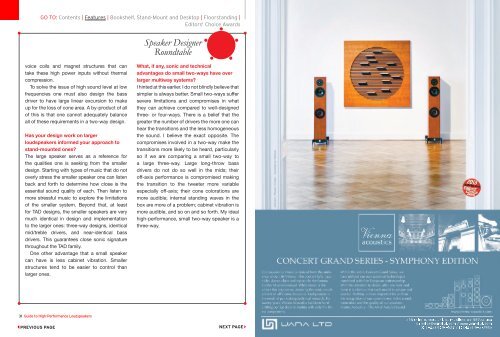LOUDSPEAKERS
Create successful ePaper yourself
Turn your PDF publications into a flip-book with our unique Google optimized e-Paper software.
go to: Contents | Features | Bookshelf, Stand-Mount and Desktop | Floorstanding |<br />
Editors' Choice Awards<br />
Speaker Designer<br />
Roundtable<br />
voice coils and magnet structures that can<br />
take these high power inputs without thermal<br />
compression.<br />
To solve the issue of high sound level at low<br />
frequencies one must also design the bass<br />
driver to have large linear excursion to make<br />
up for the loss of cone area. A by-product of all<br />
of this is that one cannot adequately balance<br />
all of these requirements in a two-way design.<br />
Has your design work on larger<br />
loudspeakers informed your approach to<br />
stand-mounted ones<br />
The large speaker serves as a reference for<br />
the qualities one is seeking from the smaller<br />
design. Starting with types of music that do not<br />
overly stress the smaller speaker one can listen<br />
back and forth to determine how close is the<br />
essential sound quality of each. Then listen to<br />
more stressful music to explore the limitations<br />
of the smaller system. Beyond that, at least<br />
for TAD designs, the smaller speakers are very<br />
much identical in design and implementation<br />
to the larger ones: three-way designs, identical<br />
mid/treble drivers, and near-identical bass<br />
drivers. This guarantees close sonic signature<br />
throughout the TAD family.<br />
One other advantage that a small speaker<br />
can have is less cabinet vibration. Smaller<br />
structures tend to be easier to control than<br />
larger ones.<br />
What, if any, sonic and technical<br />
advantages do small two-ways have over<br />
larger multiway systems<br />
I hinted at this earlier. I do not blindly believe that<br />
simpler is always better. Small two-ways suffer<br />
severe limitations and compromises in what<br />
they can achieve compared to well-designed<br />
three- or four-ways. There is a belief that the<br />
greater the number of drivers the more one can<br />
hear the transitions and the less homogeneous<br />
the sound. I believe the exact opposite. The<br />
compromises involved in a two-way make the<br />
transitions more likely to be heard, particularly<br />
so if we are comparing a small two-way to<br />
a large three-way. Large long-throw bass<br />
drivers do not do so well in the mids; their<br />
off-axis performance is compromised making<br />
the transition to the tweeter more variable<br />
especially off-axis; their cone colorations are<br />
more audible; internal standing waves in the<br />
box are more of a problem; cabinet vibration is<br />
more audible, and so on and so forth. My ideal<br />
high-performance, small two-way speaker is a<br />
three-way.<br />
31 Guide to High-Performance Loudspeakers www.theabsolutesound.com<br />
728 third street, unit c, mukilteo wa 98275 usa<br />
e: sales@vanaltd.com / www.vanaltd.com<br />
previous page NEXT page<br />
p: (425) 610-4532 NEXT / f: (425) page 645-7985

















